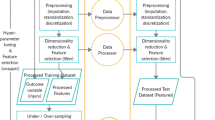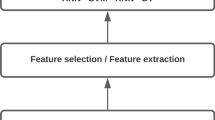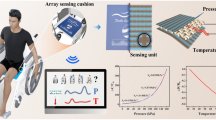Abstract
Clinical assessment plays a major role in post-stroke rehabilitation programs for evaluating impairment level and tracking recovery progress. Conventionally, this process is manually performed by clinicians using chart-based ordinal scales which can be both subjective and inefficient. In this paper, a novel approach based on fuzzy logic is proposed which automatically evaluates stroke patients’ impairment level using single-channel surface electromyography (sEMG) signals and generates objective classification results based on the widely used Brunnstrom stages of recovery. The correlation between stroke-induced motor impairment and sEMG features on both time and frequency domain is investigated, and a specifically designed fuzzy kernel classifier based on geometrically unconstrained membership function is introduced in the study to tackle the challenges in discriminating data classes with complex separating surfaces. Experiments using sEMG data collected from stroke patients have been carried out to examine the validity and feasibility of the proposed method. In order to ensure the generalization capability of the classifier, a cross-validation test has been performed. The results, verified using the evaluation decisions provided by an expert panel, have reached a rate of success of the 92.47%. The proposed fuzzy classifier is also compared with other pattern recognition techniques to demonstrate its superior performance in this application.








Similar content being viewed by others
References
Allin S, Baker N, Eckel E, Ramanan D (2010) Robust tracking of the upper limb for functional stroke assessment. IEEE Trans Neural Syst Rehabil Eng 18(5):542–550. doi:10.1109/TNSRE.2010.2047267
American Association for Artificial Intelligence: an empirical study of the naive Bayes classifier (2001)
Asghari Oskoei M, Hu H (2007) Myoelectric control systems—a survey. Biomed Signal Process Control 2(4):275–294
Bonato P, Roy S, Knaflitz M, De Luca C (2001) Time-frequency parameters of the surface myoelectric signal for assessing muscle fatigue during cyclic dynamic contractions. IEEE Trans Biomed Eng 48(7):745–753
Brunnstrom S (1966) Motor testing procedures in hemiplegia: based on sequential recovery stages. Phys Ther 46(4):357–375
Brunnström S (1970) Movement therapy in hemiplegia: a neurophysiological approach. Medical Dept., Harper & Row, New York
Carey L (2012) Stroke rehabilitation: insights from neuroscience and imaging. OUP, Oxford
Chen Y, Zhou Y, Cheng X, Mi Y (2013) Upper limb motion recognition based on two-step SVM classification method of surface EMG. Int J Control Autom 6(3):249–266
Chiang J, Wang J, McKeown M (2008) A hidden Markov, multivariate autoregressive (HMM-mAR) network framework for analysis of surface EMG (sEMG) data. IEEE Trans Signal Process 56(8):4069–4081
Chiang J, Wang Z, McKeown M (2008) A windowed eigenspectrum method for multivariate semg classification during reaching movements. IEEE Signal Process Lett 15:293–296. doi:10.1109/LSP.2008.917801
Chiang J, Wang Z, McKeown M (2006) A time-varying eigenspectrum/SVM method for sEMG classification of reaching movements in healthy and stroke subjects. In: 2006 IEEE international conference on acoustics, speech and signal processing, vol 2. ICASSP 2006 Proceedings, pp II–II. doi:10.1109/ICASSP.2006.1660561
Chiu S (1994) Fuzzy model identification based on cluster estimation. J Intell Fuzzy Syst 2:267–278
Cortes C, Vapnik V (1995) Support-vector networks. Mach Learn 20(3):273–297
De Luca C (1997) The use of surface electromyography in biomechanics. J Appl Biomech 13(2):135–163
Dewey H, Sherry L, Collier J (2007) Stroke rehabilitation 2007: what should it be? Int J Stroke 2(3):191–200
Farina D, Merletti R, Enoka R (2004) The extraction of neural strategies from the surface emg. J Appl Physiol 96(4):1486–1495
Feigin V, Forouzanfar M, Krishnamurthi R, Mensah G, Connor M, Bennett D, Moran A, Sacco R, Anderson L, Truelsen T, O’Donnell M, Venketasubramanian N, Barker-Collo S, Lawes C, Wang W, Shinohara Y, Witt E, Ezzati M, Naghavi M (2014) Global and regional burden of stroke during 1990–2010: findings from the global burden of disease study 2010. Lancet 383(9913):245–255
Geng Y, Zhang L, Tang D, Zhang X, Li G (2013) Pattern recognition based forearm motion classification for patients with chronic hemiparesis. In: Proceedings of IEEE EMBS, pp 5918–5921
Ghasemzadeh H, Jafari R, Prabhakaran B (2010) A body sensor network with electromyogram and inertial sensors: multimodal interpretation of muscular activities. IEEE Trans Inf Technol Biomed 14(2):198–206
Gladstone D, Danells C, Black S (2002) The fugl-meyer assessment of motor recovery after stroke: a critical review of its measurement properties. Neurorehabil Neural Repair 16(3):232–240
Ho YC, Agrawala A (1968) On pattern classification algorithms introduction and survey. Proc IEEE 56(12):2101–2114
Huang S, Luo C, Ye S, Liu F, Xie B, Wang C, Yang L, Huang Z, Wu J (2012) Motor impairment evaluation for upper limb in stroke patients on the basis of a microsensor. Int J Rehabil Res 35(2):161–169
Kaiser J (1993) Some useful properties of teager’s energy operators. In: 1993 IEEE international conference on acoustics, speech, and signal processing, vol 3. ICASSP-93, pp 149–152
Kaiser J (1990) On a simple algorithm to calculate the ‘energy’ of a signal. In: 1990 international conference on acoustics, speech, and signal processing, vol 1. ICASSP-90, pp 381–384
Kotsiantis SB (2007) Supervised machine learning: a review of classification techniques. In: Proceedings of the 2007 conference on emerging artificial intelligence applications in computer engineering: real word AI systems with applications in eHealth, HCI, information retrieval and pervasive technologies. IOS Press, Amsterdam, The Netherlands, pp 3–24
Krzanowski WJ (ed) (1988) Principles of multivariate analysis: a user’s perspective. Oxford University Press, Inc., New York
Lee JD, Cheng, YT, Liu LC, Wu CY (2007) A study of evaluation parameters for stroke patients’ Brunnstrom recovery stages. In: IEEE Region 10 Annual International Conference, Proceedings/TENCON
Liparulo L, Proietti A, Panella M (2015) Fuzzy clustering using the convex hull as geometrical model. Adv Fuzzy Syst 15:1–13. doi:10.1155/2015/265135
Liparulo L, Proietti A, Panella M (2013) Fuzzy membership functions based on point-to-polygon distance evaluation. In: Proceedings of IEEE international conference on fuzzy systems (FUZZ-IEEE 2013), pp 1–8. doi:10.1109/FUZZ-IEEE.2013.6622449
Liparulo L, Proietti A, Panella M (2015) Improved online fuzzy clustering based on unconstrained kernels. In: Proceedings of IEEE international conference on fuzzy systems (FUZZ-IEEE 2015), pp 1–8. doi:10.1109/FUZZ-IEEE.2015.7338065
Lyden P, Brott T, Tilley B, Welch K, Mascha E, Levine S, Haley E, Grotta J, Marler J (1994) Improved reliability of the nih stroke scale using video training. Stroke 25(11):2220–2226
Mahoney FI, Barthel DW (1965) Functional evaluation: the barthel index. Md State Med J 14:61–65
Maisto M, Panella M, Liparulo L, Proietti A (2013) An accurate algorithm for the identification of fingertips using an RGB-D camera. IEEE J Emerg Sel Top Circuits Syst 3(2):272–283. doi:10.1109/JETCAS.2013.2256830
Mamdani E, Assilian S (1975) An experiment in linguistic synthesis with a fuzzy logic controller. Int J Man Mach Stud 7(1):1–13
Mitra S, Pal S, Mitra P (2002) Data mining in soft computing framework: a survey. IEEE Trans Neural Netw 13(1):3–14
Murphy T, Corbett D (2009) Plasticity during stroke recovery: from synapse to behaviour. Nat Rev Neurosci 10(12):861–872
Nadeau C, Bengio Y (2003) Inference for the generalization error. Mach Learn 52(3):239–281. doi:10.1023/A:1024068626366
Naghdi S, Ansari NN, Mansouri K, Hasson S (2010) A neurophysiological and clinical study of Brunnstrom recovery stages in the upper limb following stroke. Brain Injury 24(11):1372–1378
National Stroke Foundation (2010) Clinical guidelines for stroke management 2010, p 79
National Stroke Audit—Rehabilitation Services Report 2012. National Stroke Foundation, Melbourne (2012)
O’Dwyer NJ, Ada L, Neilson PD (1996) Spasticity and muscle contracture following stroke. Brain 119(5):1737–1749. doi:10.1093/brain/119.5.1737
Pal N (1999) Soft computing for feature analysis. Fuzzy Sets Syst 103(2):201–221
Panella M (2011) Advances in biological time series prediction by neural networks. Biomed Signal Process Control 6(2):112–120. doi:10.1016/j.bspc.2010.09.006
Patel S, Hughes R, Hester T, Stein J, Akay M, Dy J, Bonato P (2010) A novel approach to monitor rehabilitation outcomes in stroke survivors using wearable technology. Proc IEEE 98(3):450–461. doi:10.1109/JPROC.2009.2038727
Patel S, Hughes R, Hester T, Stein J, Akay M, Dy J, Bonato P (2010) Tracking motor recovery in stroke survivors undergoing rehabilitation using wearable technology. In: 2010 annual international conference of the IEEE engineering in medicine and biology society (EMBC), pp 6858–6861
Pietrusinski M, Severini G, Cajigas I, Mavroidis C, Bonato P (2012) Design of a gait training device for control of pelvic obliquity. In: 2012 annual international conference of the IEEE engineering in medicine and biology society (EMBC), pp 3620–3623
Proietti, A., Panella, M., Leccese, F., Svezia, E. (2015) Dust detection and analysis in museum environment based on pattern recognition. Measurement 66:62–72. doi:10.1016/j.measurement.2015.01.019
Rizzi A, Buccino NM, Panella M, Uncini A (2008) Genre classification of compressed audio data. In: Proceedings of IEEE workshop on multimedia signal processing (MLSP 2008), pp 654–659 doi:10.1109/MMSP.2008.4665157
Rizzi A, Panella M, Mascioli FMF, Martinelli G (2000) A recursive algorithm for fuzzy Min–Max networks. In: Proceedings of the IEEE-INNS-ENNS international joint conference on neural networks (IJCNN 2000), vol 6, pp 541–546
Robnik-Sikonja M, Kononenko I (2003) Theoretical and empirical analysis of Relieff and RRelieff. Mach Learn 53(1–2):23–69. doi:10.1023/A:1025667309714
Rokach L, Maimon O (2008) Data mining with decision trees: theroy and applications. World Scientific Publishing Co. Inc., River Edge
Safaz I, Yilmaz B, Yaar E, Alaca R (2009) Brunnstrom recovery stage and motricity index for the evaluation of upper extremity in stroke: analysis for correlation and responsiveness. Int J Rehabil Res 32(3):228–231
Schiemanck S, Kwakkel G, Post M, Kappelle L, Prevo A (2006) Predicting long-term independency in activities of daily living after middle cerebral artery stroke: Does information from mri have added predictive value compared with clinical information? Stroke 37(4):1050–1054
Sedgwick P (2012) Pearson’s correlation coefficient. BMJ. doi:10.1136/bmj.e4483
Shah S, Harasymiw S, Stahl P (1986) Stroke rehabilitation: outcome based on Brunnstrom recovery stages. Occup Ther J Res 6(6):365–376
Specht DF (1990) Probabilistic neural networks. Neural Netw 3(1):109–118
Strong K, Mathers C, Bonita R (2007) Preventing stroke: saving lives around the world. Lancet Neurol 6(2):182–187
Sugeno M (1985) Industrial applications of fuzzy control. Elsevier Science Inc., New York
Teasell R, Meyer M, McClure A, Pan C, Murie-Fernandez M, Foley N, Salter K (2009) Stroke rehabilitation: an international perspective. Top Stroke Rehabil 16(1):44–56
Theodoridis S, Koutroumbas K (2009) Pattern recognition, 4th edn. Academic Press, Burlington
Urra O, Casals A, Jana R (2013) Evaluating spatial characteristics of upper-limb movements from EMG signals. In: XIII Mediterranean conference on medical and biological engineering and computing, vol 56(8), pp1795–1798
Yu L, Wang J, Fang Q, Wang Y (2012) Brunnstrom stage automatic evaluation for stroke patients using extreme learning machine. In: IEEE BioCAS Conf, pp 380–383
Zadeh L (1965) Fuzzy sets. Inf Control 8:338–353
Zadeh LA (1971) Similarity relations and fuzzy orderings. Inf Sci 3(2):177–200
Zadeh LA (1996) Fuzzy sets and their application to pattern classification and clustering analysis. In: Klir GJ, Yuan B (eds) Fuzzy sets, fuzzy logic, and fuzzy systems. World Scientific Publishing Co. Inc., River Edge, pp 355–393
Zhang Z, Fang Q, Gu X (2014) Fuzzy inference system based automatic Brunnstrom stage classification for upper-extremity rehabilitation. Expert Syst Appl 41(4, Part 2):1973–1980. doi:10.1016/j.eswa.2013.08.094
Zhang X, Zhou P (2012) High-density myoelectric pattern recognition toward improved stroke rehabilitation. IEEE Trans Biomed Eng 59(6):1649–1657
Zhang Z, Fang Q, Wang L, Barrett P (2011) Template matching based motion classification for unsupervised post-stroke rehabilitation. In: Proceedings of ISBB, pp 199–202
Zhang Z, Fang Q, Ferry F (2011) Upper limb motion capturing and classification for unsupervised stroke rehabilitation. In: Proceedings of IECON, pp 3832–3836
Zhang Z, Liparulo L, Panella M, Gu X, Fang Q (2015) A fuzzy kernel motion classifier for autonomous stroke rehabilitation. IEEE J Biomed Health Inform 20(3):893–901. doi:10.1109/JBHI.2015.2430524
Zhang Z, Ferry F, Fang Q, Gu X (2013) Robotic arm for unsupervised stroke rehabilitation: a pilot study using pid controller. In: 2013 International Conference on Orange Technologies (ICOT), pp 19–22
Zhou H, Hu H, Harris N (2005) Application of wearable inertial sensors in stroke rehabilitation. In: 27th annual international conference of the engineering in medicine and biology society, 2005. IEEE-EMBS 2005, pp 6825–6828
Author information
Authors and Affiliations
Corresponding author
Rights and permissions
About this article
Cite this article
Liparulo, L., Zhang, Z., Panella, M. et al. A novel fuzzy approach for automatic Brunnstrom stage classification using surface electromyography. Med Biol Eng Comput 55, 1367–1378 (2017). https://doi.org/10.1007/s11517-016-1597-3
Received:
Accepted:
Published:
Issue Date:
DOI: https://doi.org/10.1007/s11517-016-1597-3




